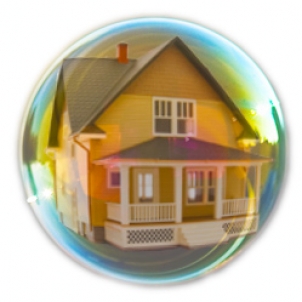
Has another U.S. Housing Market Bubble Formed?
By Stevie Duffin Updated on 2/5/2013By Daniel Duffield
Formation of the First Bubble
In 2002 as housing began a trend of cooling down, prices grew an average of 7% annually, until these increases began to rise at an even faster rate in 2004, at 8%, and again in 2005, at 12%. With these abrupt increases of home prices, many believed the market to be unsustainable, and the term “bubble” was thrown around numerous times. Not since the mid 1970’s had home prices exploded as they did in the mid 2000’s.
In general, home values grow roughly 3-4% each year during normal trends. At the time of the first housing bubble, prices were too quick to rise, leading to a complete reversal in 2007 with plummeting home prices that were a national first.
Recovering from the U.S. Housing Market Bubble Burst
Since the mortgage market collapse, the bubble burst, and the subsequent economic downturn, the housing market has made a gradual but notable recovery. However, in December, home prices grew 8% annually from the previous year, according to data from CoreLogic. While still more than 10% short of prices during the peak of the 2006 housing boom, home values are calling into question the presence of another bubble due to their rapid increases.
Experts at Clear Capital, a company which operates a four-month adjusting average price index, observe that January’s home prices have been somewhat more sluggish. Although they attribute this primarily to a seasonal stall, they indicate that Florida represents some unease.
According to Dr. Alex Villacorta, Director of Research and Analytics at Clear Capital, Florida metros, including Miami, Orlando, Tampa, and Jacksonville, did not appear on the top 15 performing market lists, whereas at least one of these housing markets made the list each month since September 2011. While these analysts note that this is not a straightforward indication that recovery has ended in Florida, they caution that it is something to keep track of, especially considering that these markets paved the way for housing recovery in late 2011 and are a serve as a prototype for the recovering markets overall.
Investors Drive Housing Prices Higher
At present, Florida’s housing market has been propelled by the surge of investors purchasing distressed homes. Likewise, other markets that were severely damaged by the housing crash, such as Phoenix, Las Vegas, and a large portion of California, have also been witness to this soaring of investor demand, driving prices ever higher.
Currently, Phoenix, AZ has seen the most prominent rise, with prices standing 26% higher than last year, according to data from Clear Capital. The percentage of Real Estate Owned (REO) sales, or the sales of foreclosed homes, stands currently at 17%. However, this figure is more than 50% less than those of only a few short years ago during the crash. Likewise, REO saturation in Las Vegas comprises 38%, and prices have risen more than 15% year-over-year. Essentially, investors have claimed a large portion of real estate and have been outbidding other buyers, especially first time home buyers, who have been forced out of the market somewhat.
In Florida, where there exists a large backlog of distressed mortgages, foreclosures delays have been particularly lengthy as a result of the “robo-signing” foreclosure processing scandal. Now that the issue has been more or less resolved, foreclosures have begun again, and these numerous foreclosed properties hitting the market simultaneously may have slowed the rise of home prices temporarily.
More troublesome is that pricing push from investors is not taking effect in some parts of the U.S., particularly the South and the Midwest.
In St. Louis, Chicago, Charlotte, and Dallas, distressed properties comprise approximately one third of the market, higher than many of the western markets, although home prices have been either unchanging or falling annually. Basically, with less investor demand in these areas, prices have not seen the same drive. With banks finishing up foreclosures in Florida, New York, and New Jersey, where judges had previously stalled the process, a greater inventory of distressed properties will be present in the market with less prospective buyers, which could lead to falling prices.
Current Trends and the Appearance of a New Housing Bubble
With these two conflicting trends, the market is splitting into two distinct patterns, with a notable part of the U.S. being pushed into trends reminiscent of the previous housing bubble.
Many investors within these bubble markets are hedge fund owners, who intended to remain within the market to profit through rental, though as prices surge, they may be incentivized to sell much sooner.
What had previously been considered safer home purchases for the long term may now be turned into the risky property flips that characterized the previous decade. However, the question remains whether a sufficient amount of non-investor buyers will be present to support this trend.
Consumer confidence has returned somewhat, with many having more faith in the return of housing market strength. With an increased national employment level, home purchase may be more of an option for many borrowers, and more homeowners have recovered from being underwater with the increased equity from rising home prices, allowing them to potentially move. Although if these borrowers listed their homes in order to attempt a sale, this would add to the current inventory, which could cause a recoil of housing prices.
With so many complicated factors involved in the housing market, it can be easy to only consider the positive aspects even among the many dire warning signs that a bubble may already have formed. Housing supply is at a low point at the moment, which has spurred prices much within the past year. However, prices have historically lagged behind sales and rather more accurately reflect the previous year’s home prices. If sales begin to turn sluggish, prices could be pushed dangerously high within the bubble markets, falling critically in the markets that have been seeing prices drop.

Didn't find the answer you wanted? Ask one of your own.
-
 What You Need To Know About Escrow
View More
What You Need To Know About Escrow
View More
-
 President Obama Initiates Lower FHA Mortgage Insurance Premiums
View More
President Obama Initiates Lower FHA Mortgage Insurance Premiums
View More
-
 What is Quantitative Easing?
View More
What is Quantitative Easing?
View More
-
 The 5 New Mortgage and Housing Trends for Summer 2013
View More
The 5 New Mortgage and Housing Trends for Summer 2013
View More
-
 Fannie Mae profitability skyrockets
View More
Fannie Mae profitability skyrockets
View More
-
 Foreclosure protections for more soldiers after lawmakers draft bill
View More
Foreclosure protections for more soldiers after lawmakers draft bill
View More
-
 FHFA: HARP success follows low mortgage rates, February refinance volume strong
View More
FHFA: HARP success follows low mortgage rates, February refinance volume strong
View More
-
 Use of Mortgage Interest Deduction Depends on Where You Live
View More
Use of Mortgage Interest Deduction Depends on Where You Live
View More
-
 HUD will sell 40,000 distressed loans in 2013
View More
HUD will sell 40,000 distressed loans in 2013
View More
-
 Mortgage Principal Reduction Could Save Taxpayers $2.8 Billion
View More
Mortgage Principal Reduction Could Save Taxpayers $2.8 Billion
View More
-
 Mortgage Applications Regain Traction after Sluggishness, Rates Continue to Fall
View More
Mortgage Applications Regain Traction after Sluggishness, Rates Continue to Fall
View More
-
 HARP 3.0 Discussions Reveal Little Hope for HARP Update
View More
HARP 3.0 Discussions Reveal Little Hope for HARP Update
View More
-
 Home Prices Rise in February According to LPS Data
View More
Home Prices Rise in February According to LPS Data
View More
-
 Balancing Act: House Committee Hears Opposing Viewpoints Over Mortgage Interest Rate Deduction
View More
Balancing Act: House Committee Hears Opposing Viewpoints Over Mortgage Interest Rate Deduction
View More
-
 Near Record Low Mortgage Rates Buoy Housing Recovery
View More
Near Record Low Mortgage Rates Buoy Housing Recovery
View More
Related Articles
Ask our community a question.
Searching Today's Rates...

Featured Lenders

